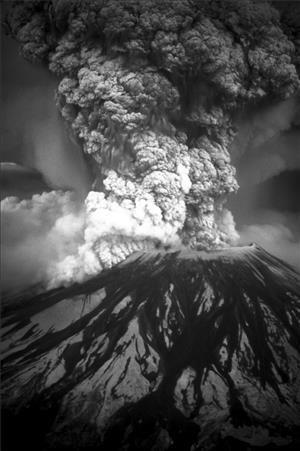Mount St. Helens once was the fifth highest mountain in Washington. Now, because of a huge eruption on May 18, 1980, it is only the 30th highest peak in the state. There were many signs that the mountain was going to erupt before it finally did. Some people took the warnings seriously and some did not. There was terrible damage to the property surrounding the mountain and many lives were lost. But it was not the first time that Mount St. Helens had erupted. Diaries of early explorers and missionaries -- and many stories or legends passed down through Native American tribes -- describe volcanic eruptions that happened long ago. (This essay was written for students in third and fourth grade who are studying Washington State History and for all beginning readers who want to learn more about Washington. It is one of a set of essays called HistoryLink Elementary, all based on existing HistoryLink essays.)
Ring of Fire
Mount St. Helens is an active volcano located in Skamania County. It is part of the Cascade Mountain chain and the Pacific Ring of Fire.
Explorer George Vancouver spotted the mountain when he was surveying the northern Pacific Coast from 1792 to 1794. He named it for his friend Alleyne Fitzherbert, whose title was Baron St. Helens.
Mount St. Helens is most well-known for the huge eruption of May 18, 1980. But there are clues that the mountain erupted before. One eruption happened around 1800. Explorers, traders, and missionaries heard reports from various people, including the Sanpoil Indians of eastern Washington, who described the ash fallout from that time. Thirty years later, a doctor at Fort Vancouver wrote about darkness and haze that was most likely the result of another volcanic eruption. And in 1842, Reverend Josiah Parrish, a missionary in Oregon, described watching Mount St. Helens erupt. Other small eruptions were reported but none of these other early events were officially confirmed.
In 1968, scientists who studied rocks and mountains warned that Mount St. Helens could erupt again at any time. They watched the mountain closely for 12 years. Then, on March 27, 1980, there was an explosion of steam and a small crater opened on the peak of the mountain. The rising magma or lava inside the mountain caused the north side to bulge out. That side of the mountain grew at a rate of five or six feet every day and soon stuck out more than 300 feet.
On the morning of May 18, 1980, there was an earthquake under the mountain. The pressure in the mountain became so strong that it finally caused an explosion. The top of the mountain -- which was made up of rock, snow, and ice -- started to slide. It rushed down the north side at speeds of up to 200 miles per hour. This avalanche covered a 24-mile area and was piled up as deep as 600 feet in some spots. Huge trees were stripped of their bark and blown down like toothpicks.
At the same time, sound and shock waves shot up into the sky. An ash plume reached 15 miles above the mountain in 15 minutes. The ash cloud blocked the sun and turned the day into total darkness. The ash poured out of the top of Mount St. Helens for nine hours. The winds blew clouds of black ash to the east, reaching Yakima in an hour’s time. Up to 10 inches of ash fell close to the mountain and one-half inch fell over 300 miles away. The ash cloud was so huge that it went all the way around the world in 15 days.
The blast was so powerful that all trees and other vegetation within six miles of the mountain were immediately destroyed. Sadly, some human lives were also lost in the explosion. Fifty-seven people including several children died as a result of the eruption of Mount St. Helens. Most of those who were killed had not listened to the warnings of a possible eruption and were too close to the mountain when it blew up.
Before the eruption, Mount St. Helens was listed as the fifth highest mountain in Washington. Now it is only the 30th highest peak. In 1982, the President and Congress created the National Volcanic Monument there to allow for research, recreation, and education.

